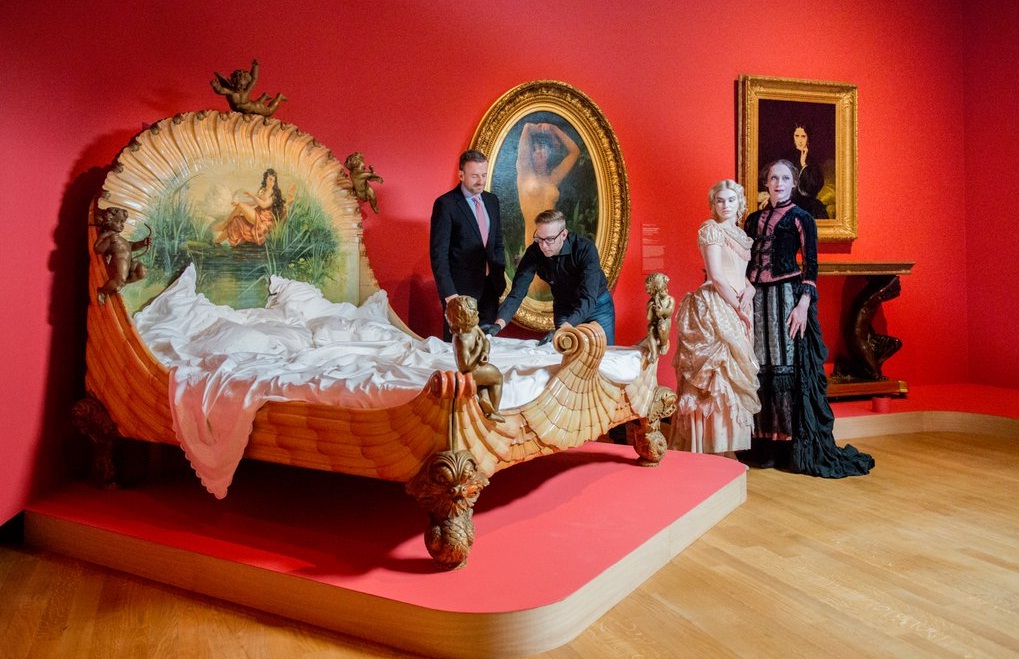Art and Culture
Van Gogh Museum shows Paris prostitution through paintings

Easy Virtue. Prostitution in French Art, 1850-1910 exhibit at the Van Gogh Museum in Amsterdam (Photo courtesy of the official Twitter page of Van Gogh Museum).
AMSTERDAM—The ballet rehearsal painted in 1874 by French artist Edgar Degas looks, at first glance, like an innocent portrayal of dancers limbering up for a performance. But who’s that man in the shadowy background, straddling a chair, his top hat pulled down low over his eyes?
“Why is he there? What’s he doing? Was he a member of staff of the Paris Opera? It’s possible,” said Prof. Richard Thomson, one of the curators of a new exhibition at Amsterdam’s Van Gogh Museum. “Or was he the lover of one of the dancers? Somebody who kept a dancer? These are the things we don’t know.”
Ambiguity is one of the key themes of the exhibition opening Friday that explores artists’ fascination with prostitution in Paris in the second half of the 19th and start of the 20th centuries.
The exhibition was a hit at the Musee d’Orsay in Paris before travelling to Amsterdam. “Sex sells,” says Van Gogh Museum director Axel Rueger.
But the show is about much more than sex, Rueger said Wednesday while standing in front of a gilded bed decorated with cherubs, its white sheets rumpled. The bed dominates a corner of one of the galleries where more than 100 works by some 40 different artists hang on walls painted the lurid reds and pinks of a boudoir in a Paris brothel.
Divided into four themes, it first explores the age of ambiguity as Paris grew into a centre of conspicuous consumption the 19th century where everything, including women, could be bought and sold and nobody could be quite sure whether the woman on a street corner was a prostitute or not.
“Hierarchies disappeared. People often slipped into unemployment and had nothing to back them up, so prostitution was flourishing,” said Thomson, the Watson Gordon Professor of Fine Art at the University of Edinburgh. “People were uncertain about identity. Ambiguity made questions get raised: Who’s who? Will she? Won’t she? Is she, isn’t she?”
The exhibition then looks at Parisian prostitution’s superstars—the courtesans—through ostentatious portraits and some of their belongings, including a walking cane that hid a dainty—if a whip can be dainty—“cat-o-six tails” that would not look out of place in “Fifty Shades of Grey.”
Courtesans—effectively high-priced 19th century call girls—“were independent women who had become extremely successful and highly regarded in society and they became fashion icons and sort of celebrities,” Rueger said.
A gallery upstairs exposes life in brothels, including several paintings by the artist whose name is most closely linked to Parisian nightlife—Henri de Toulouse-Lautrec.
“What’s interesting about his work is that he depicts things as he sees them but also with compassion,” Rueger said. “He doesn’t glamorize the subject, and he also, for example, shows scenes in the brothels of a very personal nature when the women are just waiting around or are waiting for doctor’s examinations.”
The brothel section does not flinch from the seedy side of prostitution, including a sinister pastel and gouache work, “The Hour of the Flesh,” by Emile Bernard. There’s a range of photographs from early pornography—which often used prostitutes as models—to police records and the scarred faces and bodies of syphilis victims.
Finally, the exhibition moves on to the early 20th century and depictions of Paris prostitution by international artists drawn to the city including Pablo Picasso and Edvard Munch.
There are a handful of Van Gogh paintings, although he is not well-known for depicting prostitution and ultimately turned his back on Paris’ bustling nightlife.
But the museum dedicated to Van Gogh is still a fitting host for the exhibition, in part because the Dutch capital is still home to one of the world’s best-known red light districts.
“The Van Gogh museum is in Amsterdam and of course we cannot deny that Amsterdam also has a certain reputation on that subject,” Rueger said with a smile.
The exhibition “Easy Virtue. Prostitution in French Art, 1850-1910” opens Friday and runs until June 19. Tickets to the Van Gogh Museum cost 17 euros ($19) for adults. Children under 18 get in for free.





















